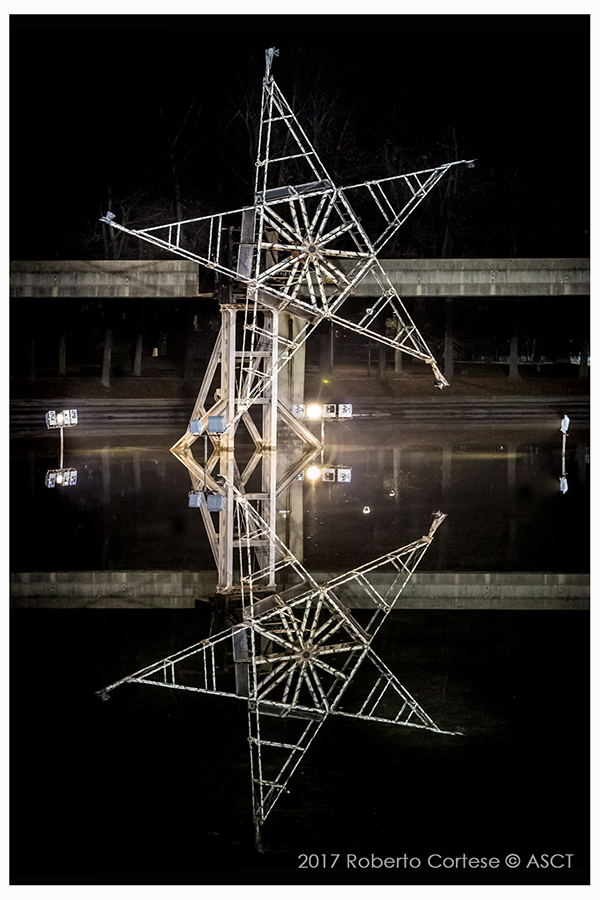The river, the two bridges, the Murazzi, the star, the iron, the mirrors, the shovels, the phosphorous, the containers, the sprays, the headlights, the black lights, the timer... The night, the exhausting cold, the black lights always on, the headlights that go out, the phosphorous that becomes incandescent, like an active memory... How much memory I have lost... The lights come back on, the mirrors reflect the rays... Marzio, Mariano, red stars... It is the feast washed by the spray, by the snow, it is the feast of concrete illusion... Perhaps it is the feast that wishes to become the light of art.
Gilberto Zorio
Gilberto Zorio’s Luce Fontana Ruota (Wheel Fountain Light) is a five-pointed star over eleven metres in diameter, which, supported by a vertical arm, rotates like a mill, skimming the surface of the water and thus generating small, continuous waterfalls. Covered in phosphorus, the work takes on a close to light blue colour. The figure of the star is perhaps the most recurrent in Zorio’s work: in crystal, in leather, with glowing nickel-chrome outlines, composed of javelins, or in the form of a brick turret with a five-pointed section, it runs through the artist’s entire career. And phosphor had already been used on several occasions, starting with the Poing phosphorescent wax fist exhibited by Sperone in 1971 and in Kassel in 1972.
Zorio’s work is characterised by the use of industrial materials that, as they transform, become carriers of latent energies and tensions. The condition of darkness or light, the evaporation of seawater (in Tenda, 1967) or chemical reactions (Piombi, 1968) make processuality its hallmark. One of the protagonists of Arte Povera, since 1967 Gilberto Zorio (Andorno Micca, Biella, 1944) began an intense exhibition activity that brought his works to some of the most important international institutions, including: Kunstmuseum, Lucerne (1976); Stedelijk Museum, Amsterdam (1979); Pinacoteca, Ravenna (1982); Kunstverein, Stuttgart (1985); Centre d'Art Contemporain, Geneva and Centre Georges Pompidou, Paris (1986); Tel Aviv Museum, Tel Aviv and Stedelijk Van Abbemuseum, Eindhoven (1987); IVAM, Valencia (1991); Centro per l'Arte Contemporanea Pecci, Prato and Musèe d'Art Moderne et d'Art Contemporain, Nice (1992); Galleria Civica d'Arte Contemporanea, Trento (1996); Dia Center for the Arts, New York (2001); Milton Keynes Gallery, Milton Keynes (2008); MAMbo, Bologna (2009); CGAC, Santiago de Compostela and MACRO, Rome (2010); Castello di Rivoli Museo d'Arte Contemporanea, Rivoli-Turin (2017).
He has participated in five editions of the Venice Biennale (1978, 1980, 1986, 1995, 1997) and two documenta, Kassel (1972 and 1992).
Silvia Maria Sara Cammarata
Current Location
aghetto of Italia '61, corso Unità d'Italia, Turin
Previous locations
in 1999 at the Murazzi del Po Gipo Farassino; since 2000, the permanent location of the artwork is laghetto of Italia '61, corso Unità d'Italia.
Specifiche tecniche
Steel supporting structure, light starshaped steel mill, buckets, plastic tubes, phosphorus and plastic material painting, control panel.


